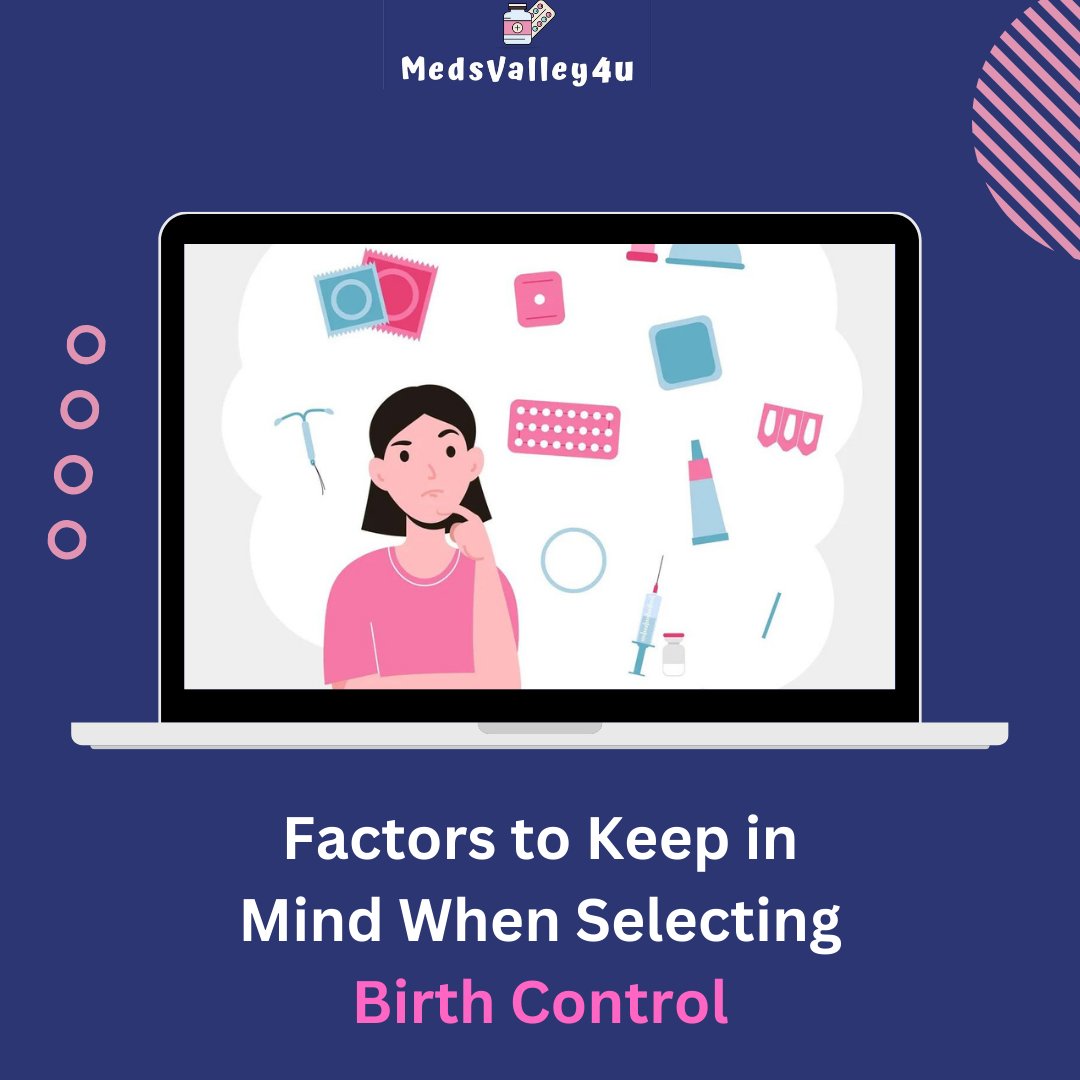Choosing the right birth control method is a personal and important decision. It involves weighing various factors, including effectiveness, health conditions, lifestyle, future reproductive goals, and preferences. With so many options available—from hormonal methods like the pill to long-term devices such as intrauterine devices (IUDs) and natural methods—it’s crucial to understand the benefits and potential drawbacks of each.
Here’s an in-depth guide on the factors to consider when selecting birth control to help you make an informed choice that aligns with your health, goals, and lifestyle.
1. Effectiveness
One of the primary concerns when selecting birth control is its effectiveness in preventing pregnancy. Effectiveness is usually measured in two ways: typical use and perfect use.
- Perfect Use: This refers to how effective the method is when used exactly as instructed without any mistakes.
- Typical Use: This accounts for human error or inconsistent usage and represents how effective the method is in real-world conditions.
Highly Effective Methods
- Intrauterine Devices (IUDs): Both hormonal and copper IUDs are more than 99% effective and can last between 3-12 years depending on the type.
- Implants: The birth control implant (like Nexplanon) is over 99% effective and works for up to 3 years.
- Sterilization: Tubal ligation for women and vasectomy for men are permanent methods of birth control and are nearly 100% effective.
Moderately Effective Methods
- Hormonal Pills, Patches, and Rings: The pill, birth control patch, and vaginal ring are around 91% effective with typical use.
- Injectable Contraceptives: These are about 94% effective with typical use and require an injection every 3 months.
Least Effective Methods
- Barrier Methods: Condoms (male and female), diaphragms, and sponges are generally less effective compared to other methods, with effectiveness rates ranging from 71% to 88%.
- Natural Family Planning: This includes the rhythm method and fertility awareness, which are about 76% effective with typical use.
2. Health Conditions
Your health plays a critical role in determining which birth control method is suitable for you. Some methods are not recommended if you have certain health issues.
Hormonal Birth Control and Health Risks
- High Blood Pressure: Hormonal methods like the pill can raise blood pressure, so they might not be recommended if you already have hypertension.
- Blood Clot Risk: Women with a history of blood clots or who are prone to clotting should avoid combination hormonal methods (those that contain both estrogen and progestin) such as the combined pill, patch, or ring, as they increase the risk of blood clots.
- Migraine Sufferers: Those who experience migraines with aura may also need to avoid estrogen-containing birth control as it can increase the risk of stroke.
- Cancer History: Some hormonal birth control methods may not be suitable for women with a personal or family history of certain cancers, particularly breast cancer.
Non-Hormonal Options for Health Conditions
- For individuals who cannot take hormones, non-hormonal options like the copper IUD, condoms, or sterilization are safer alternatives.
3. Side Effects and Comfort Level
Each birth control method comes with potential side effects, and these vary from person to person. It’s important to be aware of the possible side effects and how they might impact your overall health and comfort.
Hormonal Side Effects
- Pills, Patches, Rings, and Shots: These can cause side effects like nausea, breast tenderness, headaches, mood changes, and changes in menstrual flow.
- Implants and Hormonal IUDs: These may lead to irregular bleeding, lighter periods, or no periods at all.
Non-Hormonal Side Effects
- Copper IUD: This can lead to heavier periods or more intense menstrual cramps, especially in the first few months.
- Barrier Methods: Condoms or diaphragms can cause irritation or allergic reactions in some people, especially if they’re sensitive to latex.
Consider how much you are willing to tolerate certain side effects. For instance, if you value a method that lightens or stops your period, a hormonal option might be more appealing. On the other hand, if you prefer to avoid hormones altogether due to side effects, non-hormonal options like the copper IUD or natural methods might be better.
4. Frequency of Use
How frequently you need to use or manage the method is an important practical consideration. Some birth control methods require daily attention, while others can last for years without maintenance.
Long-Term, Low-Maintenance Methods
- IUDs and Implants: These are great options for people who want a “set-it-and-forget-it” approach, as they provide long-term protection (up to 12 years in some cases) with no daily or monthly upkeep.
Short-Term Methods
- Daily Pill: Birth control pills must be taken at the same time every day for maximum effectiveness. Forgetting even one dose can increase the risk of pregnancy.
- Patch and Ring: These require a bit less attention but still need to be replaced regularly (weekly for the patch, monthly for the ring).
- Barrier Methods: Condoms, diaphragms, and other barrier methods must be used every time you have sex.
Natural Methods
- Fertility Awareness or Rhythm Method: These require daily monitoring of your cycle and fertility signals (like basal body temperature and cervical mucus), so they demand significant attention and commitment.
5. Reversibility and Future Fertility Plans
If you’re planning to have children in the future, you’ll want to choose a method that allows for a quick return to fertility. Some birth control options take longer for fertility to return once you stop using them, while others allow immediate conception.
Quick Return to Fertility
- Barrier Methods: These allow for an immediate return to fertility once you stop using them.
- IUDs and Implants: Fertility typically returns rapidly after removal.
Delayed Return to Fertility
- Injectable Contraceptives: Depo-Provera, for example, may delay fertility for up to a year after the last injection.
Permanent Methods
- Sterilization: Both tubal ligation and vasectomy are intended to be permanent and are not recommended if you wish to have children in the future. While tubal ligation reversal is possible, it is not guaranteed to be effective.
6. Protection Against Sexually Transmitted Infections (STIs)
While many birth control methods are effective at preventing pregnancy, not all of them protect against STIs. If protection against infections is a concern, especially if you have multiple partners or are in a non-monogamous relationship, this is an important factor to consider.
STI Protection Methods
- Condoms (Male and Female): These are the only birth control methods that protect STIs. Male condoms, when used correctly, are about 85% effective in preventing pregnancy and can significantly reduce the risk of transmitting infections like HIV, gonorrhea, and chlamydia.
No STI Protection
- Hormonal Methods, IUDs, and Sterilization: None of these methods protect against STIs, so they should be combined with condoms or other preventive measures if STI protection is needed.
7. Personal Preferences and Lifestyle of Birth Control
Your daily routine, comfort level, and personal preferences also play a significant role in selecting birth control. Factors like sexual activity, convenience, and personal beliefs should all be taken into account.
- Religious or Ethical Beliefs: Some individuals prefer natural family planning or barrier methods due to religious or ethical beliefs against hormonal or permanent birth control options.
- Sexual Frequency: If you have sex infrequently, barrier methods like condoms may be sufficient and more convenient than methods that require daily or continuous use.
- Convenience: For those with a busy lifestyle, low-maintenance methods like IUDs or implants may be preferable. On the other hand, individuals who are comfortable with routine and don’t mind taking a daily pill may find oral contraceptives easy to manage.
8. Cost and Accessibility
The cost of birth control and access to healthcare can vary widely depending on your location, insurance coverage, and financial situation. Some methods, such as the pill or condoms, are relatively inexpensive, while others, like IUDs or sterilization, can have higher upfront costs but offer long-term savings.
Insurance and Coverage
- Affordable Care Act (ACA): In the U.S., many birth control methods are covered by insurance under the ACA, but some exceptions apply. It’s essential to check your plan for coverage details.
- Low-Cost Clinics: For those without insurance, community health clinics and Planned Parenthood often offer low-cost or sliding-scale services for contraception.
Conclusion
Choosing the right birth control is a deeply personal decision that depends on various factors, including effectiveness, health conditions, lifestyle, side effects, and future reproductive goals. Understanding the pros and cons of each option and considering how each aligns with your health, lifestyle, and preferences will help you make an informed decision. Consultation with a healthcare provider can provide valuable insights into which method may be the best fit for you based on your individual needs.






Write a comment
Your email address will not be published. All fields are required